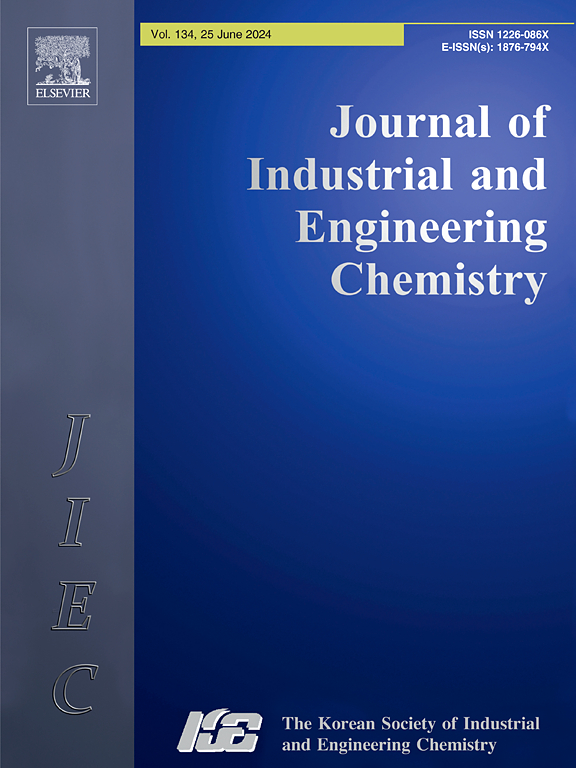柔性MXene/PVDF复合压电器件(FPED),用于能量收集和智能物联网驱动游戏的双重应用
IF 5.9
3区 工程技术
Q1 CHEMISTRY, MULTIDISCIPLINARY
Journal of Industrial and Engineering Chemistry
Pub Date : 2025-02-24
DOI:10.1016/j.jiec.2025.02.027
引用次数: 0
摘要
能量收集和物联网技术的最新进展提升了柔性压电材料的重要性,特别是它们在能量产生和电子设备传感器中的双重作用。本研究通过原位化学反应和水热处理合成Ti3C2Tx (MXene),并将其集成到PVDF基体中,采用溶剂铸造法制备柔性MXene/PVDF复合器件(FPED)。结构和形态分析证实MXene成功集成到PVDF中,从而增强了柔性晶体结构,并显着改善了压电性能。与PVDF器件(VOC ~ 2.02 v)相比,FPED通过改善界面极化和增强负载下的电荷转移性能,表现出更高的压电性能(VOC ~ 7.98 v)。通过有效地将应力从MXene层传递到PVDF矩阵,FPED还显示出更好的应力耐受性。此外,FPED在22 μF的电容中,在12 s内存储电能(VOC ~ 2.30 V),并通过手指轻敲为led供电,表现出优异的性能。FPED显示了通过人类活动收集和监测能量的巨大潜力。此外,FPED在基于物联网的系统中用作智能游戏控制器,允许玩家通过手指敲击来控制游戏中的动作,如跳跃、飞行、行走、击打和粉碎。这些乐观的结果表明,制造的柔性MXene/PVDF复合材料可以具有双重性能,并为下一代小能量电子产品和智能物联网系统提供动力。本文章由计算机程序翻译,如有差异,请以英文原文为准。

Flexible MXene/PVDF composite-based piezoelectric device (FPED) for dual applications in energy harvesting and smart IoT-driven gaming
Recent advances in energy harvesting and IoT technologies elevate the significance of flexible piezoelectric materials, particularly their dual role in energy generation and functioning as sensors in electronic devices. In this study, Ti3C2T (MXene), synthesized via in-situ chemical reactions and hydrothermal treatment, and integrated into a PVDF matrix to create a flexible MXene/PVDF composite device (FPED) using the solvent-casting method. Structural and morphological analyses confirmed the successful integration of MXene into PVDF, resulting in an-enhanced flexible crystalline structure and significantly improved piezoelectric properties. The FPED exhibited higher piezoelectric performance (V 7.98 V.) compared to the PVDF device (V 2.02 V.), by improving the interfacial polarization and enhancing charge transfer properties under loads. FPED also showed improved stress tolerance by efficiently transferring stress from MXene layers to the PVDF matrix. In addition, FPED exhibited excellent performance in storing electrical energy (V 2.30 V) within 12 s in a 22 F capacitor and powering LEDs by finger tapping. FPED showed significant potential for energy harvesting and monitoring through human activity. Furthermore, FPED used as a smart gaming controller in IoT-based systems, allowing players to control in-game actions such as jumping, flying, walking, hitting, and smashing by finger tapping. These optimistic results suggest that the fabricated flexible MXene/PVDF composite can possess dual properties and power the next generation of small-energy electronics and smart IoT systems.
求助全文
通过发布文献求助,成功后即可免费获取论文全文。
去求助
来源期刊
CiteScore
10.40
自引率
6.60%
发文量
639
审稿时长
29 days
期刊介绍:
Journal of Industrial and Engineering Chemistry is published monthly in English by the Korean Society of Industrial and Engineering Chemistry. JIEC brings together multidisciplinary interests in one journal and is to disseminate information on all aspects of research and development in industrial and engineering chemistry. Contributions in the form of research articles, short communications, notes and reviews are considered for publication. The editors welcome original contributions that have not been and are not to be published elsewhere. Instruction to authors and a manuscript submissions form are printed at the end of each issue. Bulk reprints of individual articles can be ordered. This publication is partially supported by Korea Research Foundation and the Korean Federation of Science and Technology Societies.

 求助内容:
求助内容: 应助结果提醒方式:
应助结果提醒方式:


